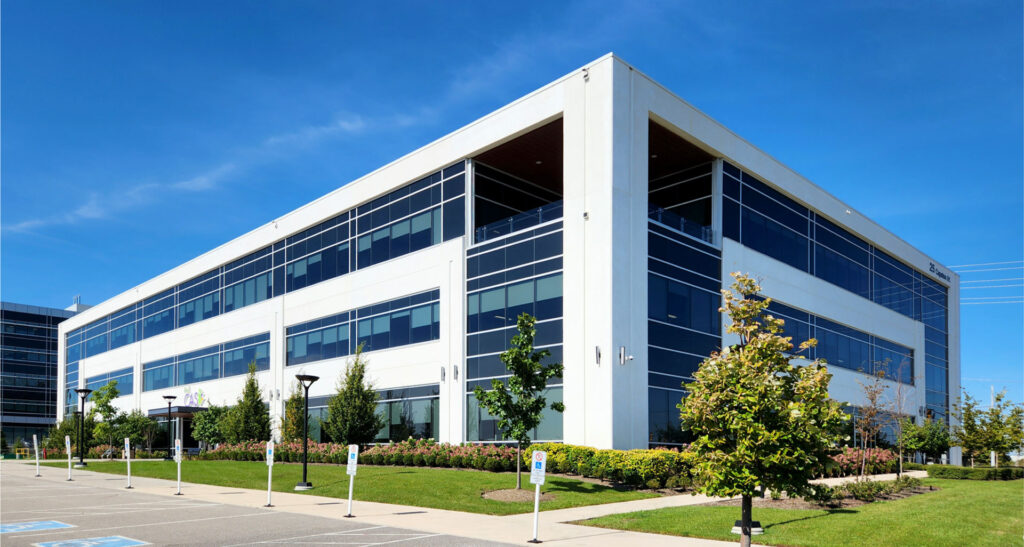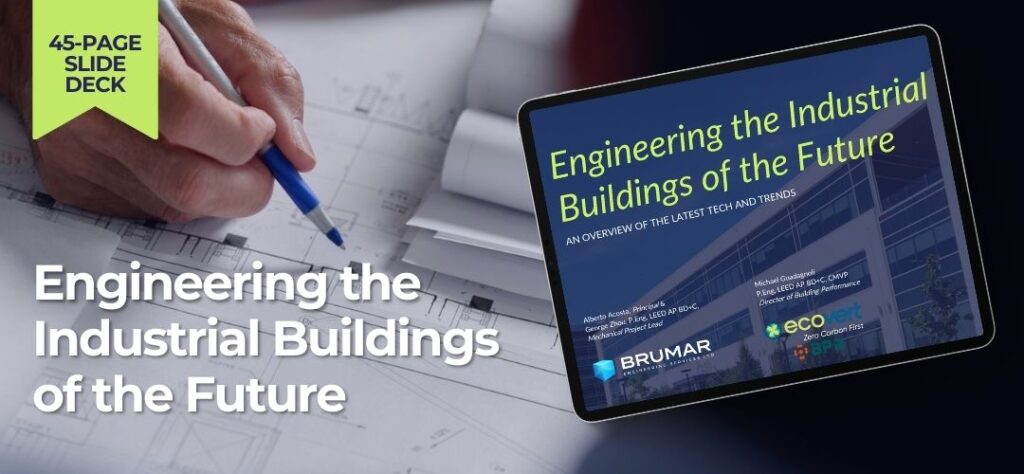PROJECTS
Richmond Hill, ON Canada
ABOUT
SERVICES
PROJECTS +
INSIGHTS
CONTACT US
+
RICHMOND HILL, ON CANADA | (+1) 905-771-7798
GROW WITH US AT BRUMAR
PROJECTS -
ABOUT
SERVICES
INSIGHTS
CONTACT US
+
RICHMOND HILL, ON CANADA | (+1) 905-771-7798
GROW WITH US AT BRUMAR
Engineering the Green Buildings of the Future

In spring 2025, Brumar Engineering partnered with Ecovert to present clients with an overview of the latest trends in green building technologies, as well as regulatory news, certifications and compliance updates, available rebates and incentives, and new energy-efficient equipment.
Hosted by Alberto Acosta of Brumar Engineering, with contributions from industry experts George Zhou, also of Brumar, and Michael Guadagnoli of Ecovert, this Green Technology seminar provided attendees with:
- An outline of the current market and where the trends are headed
- A general overview of the current designs and technologies for zero carbon buildings
- An understanding of metrics and costs
Brumar Engineering Services Ltd. is a team of skilled engineers, designers, and technical experts with a focus on Net Carbon Zero projects, particularly for commercial and industrial developments.
Alberto Acosta is the Principal and Co-Founder. George Zhou, P.Eng., LEED AP BD+C, is a Mechanical Project Lead.Ecovert has provided decarbonization sustainability consulting services since 2018. No other firm in Canada has completed as many CAGBC Zero Carbon Building™ (ZCB) certification projects as Ecovert. Michael Guadagnoli, P.Eng., LEED AP BD+C, CMVP, is the Director of Building Performance.
Highlights
Key discussion topics included:
- The evolution of industrial buildings towards more energy-efficient structures
- The implications of global net zero commitments and regulatory updates affecting Building Emissions Performance Standards (BEPS)
- The adoption of stringent green building certifications such as LEED v5
Participants learned about:
- Current rebates and incentive programs
- The evolution of HVAC technologies
- Ventilation innovations
Case studies highlighted:
- Successful implementations of green technologies
- Associated cost metrics aimed at reducing carbon footprints
“Hot” topics
Net zero commitments
Canada is among the world’s top 10 greenhouse gas (GHG) emitters – responsible for approximately 1.5% to 2% of global emissions, with very high per-capita emissions.
The federal ‘Net Zero by 2050’ commitment aligns Canada with international obligations, including the Paris Agreement and subsequent COP pledges. For businesses and municipalities, this federal commitment flows down into funding programs, standards, and carbon pricing, shaping return on investment (ROI) for low-carbon investments.
The federal government discontinued the carbon tax on April 1st, changing ROI calculations for fuel switching. Weaker financial returns and longer payback periods are expected, unless projects are supported by utility rebates, municipal standards, or corporate ESG mandates.
Big-city approaches to net zero
Canada’s largest municipalities have sustainability commitments for 2030-2040 timeframes. The City of Toronto, for instance, has committed to net-zero by 2040, driven by its TransformTO Net Zero Strategy, with major focus on building retrofits, clean transportation, and energy transition.
Other big-city plans include:
| City | Net zero target year | Documented |
| Vancouver | 2050 (carbon-neutral) | 2020 Climate Emergency Action Plan |
| Calgary | 2050 | Climate Strategy – Pathways to 2050 |
| Edmonton | 2050 (community) 2040 (corporate) | Community Energy Transition Strategy Climate Resilient Edmonton: Adaptation Strategy and Action Plan |
| Hamilton | 2050 | Hamilton’s Climate Action Strategy |
| Ottawa | 2050 | Climate Change Master Plan |
| Montreal | 2050 (carbon-neutral) | Montréal Climate Plan |
GDS and Tier 1
In Ontario, municipalities with Green Development Standards/ GDS, “Tier 1 (baseline) sustainability requirements” are mandatory and tied to the Site Plan Approval (SPA) process under the Planning Act. They set minimum, enforceable design and performance standards for new developments – covering areas like energy efficiency, water conservation, stormwater management, waste diversion, urban forestry, and active transportation. Tier 1 ensures all projects meet a consistent sustainability baseline, while higher tiers (2-4) are usually voluntary, offering incentives for exceeding the minimum.
Currently, more than 20 municipalities across the Greater Toronto Area and southwestern Ontario have adopted Green Development Standards above building code requirements. These municipalities can require developers to submit sustainability checklists, energy studies, and stormwater/ landscape plans. Thy can also withhold SPA until plans meet Tier 1.
Developers will do well to:
- Build a common baseline (“Tier 1-ready”) design package to adapt per municipality
- Budget time and money to collaborate with consultants to obtain necessary energy/ GHG reports, modelling, and checklists
- Embed net-zero-relevant design choices prior to seeking SPA
- Consider stretching to higher tiers to take advantage of incentives
Ontario Bill 17
Ontario Bill 17, officially known as Protect Ontario by Building Faster and Smarter Act, 2025 aims to accelerate the construction of infrastructure, homes, and transit by “working in close partnership with municipalities to simplify and standardize municipal development approval processes and charges”.
While builders and developers can benefit from faster approvals and lower upfront costs, they should be mindful of reputation risks, future-proofing against evolving climate standards, possible municipal pushback, and community opposition that could complicate projects under this new Act.
Standards and Certifications
A number of standards and certifications have emerged or got updated over the past year.
ZCB-Design v4
Officially launched in June 2024, the latest version of the Zero Carbon Building Design Standard responds to changes in the Canadian design and construction market since the previous version was launched in 2022. Our panel of experts explained version 4 requirements – highlighting limits to emissions, energy efficiency, and more.
Developers were urged to take note that ZCB-Design v3 must be submitted by September 2026.
LEED v5
Launched in April of this year, the latest version of the Leadership in Energy and Environmental Design green building rating system focuses on three impact areas: (i) decarbonization, (ii) human and ecological health, and (iii) resilience. While LEED v5 introduces updated credits and prerequisites reflecting net-zero targets, lifecycle carbon accounting, and equity consideration, it also requires significantly more investment ($5/sq.ft more for same certification level).
Developers should consider registering projects under v4, well before the v5 deadline, to grandfather them.
Rebates and Incentive Programs
Several programs and initiatives are currently available for business and industrial developers.
- Enspire, a BOMA initiative, is “Canada’s premier deep retrofit accelerator program, designed and delivered by BOMA Canada, to help commercial building owners and managers enhance their energy efficiency and transition to low carbon operations.”
- The initiative covers 80% of various fees for eligible mid-tier buildings
- Through their Fixed Incentive Program, Enbridge offers commercial developers incentives for eligible hybrid RTUs (electric heat pump with gas backup) (up to $8k)
- The Government of Canada’s Clean Investment Tax Credit (CT ITC) program offers up to 30% in credits for eligible assets that can include:
- Air source heat pumps
- Ground source heat pumps
- Active solar heating equipment
- Carbon capture equipment
- Solar PV (photovoltaic)
- The Retrofit Program by Save on Energy offers $860/kW for solar (for non-grid connected systems)
What’s new in HVAC
Attendees took away tips and valuable information to consider when selecting ideal HVAC systems for their next project.
Packaged RTUs
- Dual Fuel HPs for increased efficiency, lower emissions, and greater usage costs savings
- Custom Air Handlers for features that include predictive maintenance, energy recovery, and customization settings
Heat pump technology
- VRV/VRF systems for simultaneous heating/ cooling with heat recovery
- New refrigerants (R32, R454B) for lower global warming potential (but are slightly flammable (A2L class))
- Heat pumps that can extract heat even at -20°C temperatures
Ventilation
- Dual Core Energy Recovery Ventilators (ERVs) for capability to provide up to 90% energy recovery
- Note: ERVs are significantly more expensive ($24/CFM vs $6-7/CFM for Cambridge units)
- Air scrubber technology that can reduce outdoor air requirements by cleaning indoor air
- ASHRAE now recognizes air scrubbers as effective for meeting ventilation requirements
- Air-to-water heat pumps for central plants are advancing
- Note: Limited to 150°F output
- New models reaching 170-180°F are emerging to serve older buildings with high-temperature needs
Central systems
- Air Source Broilers for their capability to pre-heat incoming fresh air, leading to gas savings. Newer units are also easier to install and maintain
- Geothermal (ground-source heat pump system) continues to exceed conventional HVAC systems with consistency in performance and reduced grid strain
Ultimately, it remains important to keep essential decarbonization principles in mind when choosing systems: reduce both energy use and GHG emissions.
Case studies and cost metrics
Our panel of experts highlighted some recent projects across Ontario that have implemented various green technologies:
Dreams Logistics Centre | Mississauga
- ZCBv2 Design
Toyota Parts Distribution Center | Clarington
- LEEDv4 Gold Certified, Zero Carbon Design Certification
0 Leslie Street | Toronto
- Low carbon HVAC Design with Active Air Filtration
IKEA Distribution Centre | Hamilton
- Targeting LEED Gold, Net Zero Energy and Net Zero Carbon
Comprehensive cost comparisons
- Zero Carbon Ready: +$3/sq.ft premium with 11-13% energy savings
- ERVs with tube heaters: +$2/sq.ft premium with 50% GHG savings
- Hybrid/quasi zero carbon: +$7/sq.ft with 85% GHG savings
- Full geothermal: + $20/sq.ft premium but lower peak power requirements
A deep dive into LEED v5
Attendees expressed a keen interest in learning more about LEED v5. Stay tuned for a planned presentation in fall 2025 on the latest version of the world’s leading green building standard.
What you can do next:
- Click here to download the Green Technology seminar presentation deck for a closer look at statistics and schematics.
- Contact us with any questions you might have.
- Reach Out if you want us to host a similar seminar on this topic or others at your organization.

September 29, 2025
Designs thaT
We’re here to deliver innovative, sustainable engineering solutions that help you thrive and create a reliable, resilient future.
Work
WORK WITH US
Strategy & Website Design | Your Designer Ash
Brand Photography | Brandon Marsh Photography
Your Trusted Partner in Engineering Excellence since 1981
ABOUT
SERVICES
PROJECTS
INSIGHTS
CONTACT US
+
CAREERS
© 2025 Brumar Engineering Services, all rights reserved. Terms of Use | Privacy Policy.
#25 – 120 WEST BEAVER CREEK RD
RICHMOND HILL, ON CANADA
(+1) 905-771-7798